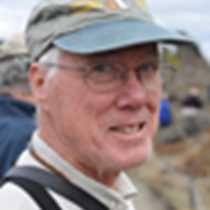The Dawes Glacier, Endicott Arm, Alaska
Last night the Sea Bird departed Alaska’s capital city of Juneau to head south down Stephens Passage. Around breakfast time we turned into a fjord system that cuts into the mountains of the Coast Range and took the more southern of the two fjords: Endicott Arm. A fjord is a glacially carved valley that is now flooded by the sea. A mere 12,000 or so years ago this valley was filled with ice rising well over 2,000 feet above present sea level and 1,000 feet below it. The movement of the ice through granitic rock carved the features that we now see: near vertical valley walls, round domes high above, and U-shaped hanging valleys that show us where tributary glaciers entered the main valley glacier. Now the glacier has retreated 22 miles into the mountains. We sailed up the fjord searching for wildlife from the foredeck of our ship. High above were mountain goats, creamy specks on impossibly steep slopes. The fjord became increasingly ice-filled, and then ended abruptly in a wall of blue ice: the Dawes Glacier. We boarded our fleet of Zodiacs and cruised toward the glacial face, stopping to admire waterfalls descending from melting snow far above. Harbor seals poked their round heads above the icy water to gaze back at us as we looked at them. Each day many tons of ice coming from the ice field above, straddling the Alaska/Canada border, ends its journey to the sea by falling off of the face of Dawes Glacier. We watched, hopefully, as small pieces of ice fell off the glacier face and our wishes were rewarded when, with a mighty roar and splash, the glacier let loose a much larger “calving”. This glacier, like most in Alaska, is in a phase of rapid retreat.
As we returned down the fjord we stopped to view mountain goats on the lower slopes of the valley, these ones accessible to our cameras. We turned into a smaller side fjord where tidal water, alternately ebbing and flooding, rushes through a narrowing of the fjord to produce the rapids called Ford’s Terror. Hordes of birds were gathered here where the rushing water makes food more available: Bonaparte’s gulls, Arctic terns, surf and white-winged scoters, and pigeon guillemots. Our Zodiacs successfully braved the rapids to reach the calm water beyond, where we cruised through the scenic grandeur of Coastal Alaska. Our day ended with an encounter with humpback whales in the slowly fading evening light of Stephens Passage as we made our way south towards Petersburg.
Last night the Sea Bird departed Alaska’s capital city of Juneau to head south down Stephens Passage. Around breakfast time we turned into a fjord system that cuts into the mountains of the Coast Range and took the more southern of the two fjords: Endicott Arm. A fjord is a glacially carved valley that is now flooded by the sea. A mere 12,000 or so years ago this valley was filled with ice rising well over 2,000 feet above present sea level and 1,000 feet below it. The movement of the ice through granitic rock carved the features that we now see: near vertical valley walls, round domes high above, and U-shaped hanging valleys that show us where tributary glaciers entered the main valley glacier. Now the glacier has retreated 22 miles into the mountains. We sailed up the fjord searching for wildlife from the foredeck of our ship. High above were mountain goats, creamy specks on impossibly steep slopes. The fjord became increasingly ice-filled, and then ended abruptly in a wall of blue ice: the Dawes Glacier. We boarded our fleet of Zodiacs and cruised toward the glacial face, stopping to admire waterfalls descending from melting snow far above. Harbor seals poked their round heads above the icy water to gaze back at us as we looked at them. Each day many tons of ice coming from the ice field above, straddling the Alaska/Canada border, ends its journey to the sea by falling off of the face of Dawes Glacier. We watched, hopefully, as small pieces of ice fell off the glacier face and our wishes were rewarded when, with a mighty roar and splash, the glacier let loose a much larger “calving”. This glacier, like most in Alaska, is in a phase of rapid retreat.
As we returned down the fjord we stopped to view mountain goats on the lower slopes of the valley, these ones accessible to our cameras. We turned into a smaller side fjord where tidal water, alternately ebbing and flooding, rushes through a narrowing of the fjord to produce the rapids called Ford’s Terror. Hordes of birds were gathered here where the rushing water makes food more available: Bonaparte’s gulls, Arctic terns, surf and white-winged scoters, and pigeon guillemots. Our Zodiacs successfully braved the rapids to reach the calm water beyond, where we cruised through the scenic grandeur of Coastal Alaska. Our day ended with an encounter with humpback whales in the slowly fading evening light of Stephens Passage as we made our way south towards Petersburg.



